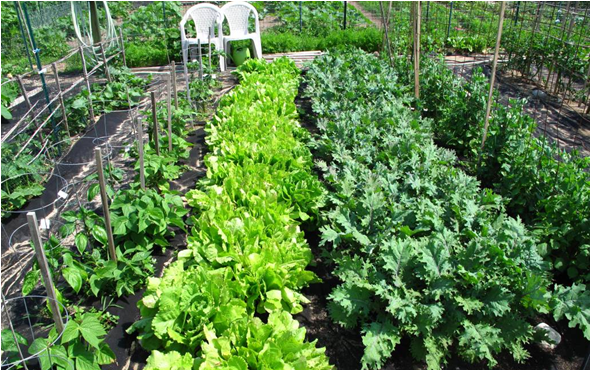Whirlygigs and Garden Gnomes: Adventures in Community Gardening
by Katie O'Sullivan
My husband and I have grown a home garden for many years, relishing the taste of heirloom tomatoes and hand-picked salad greens. We discovered long ago that there are so many more interesting varieties of squash out there to be savored, beyond the traditional green zucchini and yellow summer squash found at the supermarket.
When we moved to Cape Cod, we tried for a few years to make do with container gardens in our small yard. We interspersed squash plants among the ornamental bushes. We planted blueberry bushes and raspberries along the back fence. But we missed the flavor of real tomatoes.
Then we heard about the Harwich Community Garden. For a modest fee paid to the town's Conservation Commission, residents can sign up to garden one or more of the available plots, although newcomers are limited to one plot in their first year. We were lucky enough to sign up before they sold out.
A "community garden" is by definition a single piece of land gardened collectively by a group of people. The Harwich Garden is located off Sisson Road, and is an oasis of greenery and community spirit divided into many small sections. The myriad plots have personalities as distinct as the individual gardeners, and no two look alike.
Whirlygigs and garden gnomes guard over some of the plots. American flags fly proudly over others. Fences are fashioned out of everything from chicken wire to old screen doors strung together. An active beehive off at one end ensures good pollination throughout the growing season.
Some gardeners check their plots once or twice a week. Others seem to be in their gardens every day. Several use black plastic mulch to keep weeds at bay, while others spend hours keeping their garden rows tidy.
Veterans of the community garden bring benches and chairs to their plots, and spend hours socializing with friends as they tend their flowers and vegetables.
Community gardens exist across northern North America, but are most popular here in the Northeast, with literally thousands of community gardens in New York City, Philadephia and Boston – any place where land is at a premium, and individuals might not have yards large enough to support a garden. Cape Cod, although not an urban area, is a perfect example.
The idea of community gardening overlaps to some extent with the related movements to encourage local food production, local farmers' markets and community supported agriculture farms (CSAs) (see the related articles on CSAs in the Spring 2010 Issueand our Buy Fresh Buy Local article in the Summer 2010 Issue.)

Garden Plot at the Harwich Community Garden
Harwich is not the only Cape Cod town to host a community garden. Dennis, Wellfleet and Marstons Mills all boast gardens of their own. Other towns are in the process of creating gardens, such as the one Chatham is in the process of building off Route 28, on Lime Hill Road next to the Agway.
In Harwich, town employees clear and rototill all of the plots in the spring, after the last frost. Gardeners have until June 1st to erect fences and start to manage their gardens, else they revert back and are given to the next person on the waiting list.
Fences are recommended but not required, but almost everyone has one to keep out uninvited critters. (And marauding garden gnomes.)
There are pros and cons to working in a community environment. The pros include the camaraderie and social aspects of working in an area together with others, sharing ideas and vegetables as the season progresses.
We've handed out several of our prized Italian heirloom "zuchetta" squash, and in return brought home bags of cherry tomatoes, green beans and promises of spaghetti squash when they ripen.
We've also tried to explain our elaborate tomato reel set-up to skeptical older gardeners, who are happier sticking with their tried and true methods.
On the negative side, an individual doesn't have complete control over bugs, disease or weeds. Community garden plots are close together, so one garden's plants can be vulnerable to its neighbor's neglect. Each gardener has a shared responsibility to the garden as a whole, to not allow an infestation to run wild.
We've heard stories from more seasoned community gardeners about unscrupulous neighbors, who've been known to sneak into plots at night to harvest other people's veggies. One year, a woman lost an entire crop of tomatoes overnight. She wrote a letter to the local paper, admonishing the thieves.
Another woman's grandchildren were growing pumpkins in her plot, one of which was stolen just before the child could harvest it.
So far, we've found the positives outweighing the negatives. We can once again enjoy fresh, homegrown tomatoes and basil in our evening salad. Our children are rediscovering the joys of fresh vegetables that they help to grow and harvest. And we've made a few new friends in town.
What more can you ask for from a garden?
Benefits of Community Gardens:
- Improves the quality of life for people in the garden
- Provides a catalyst for neighborhood and community development
- Stimulates Social Interaction
- Encourages Self-Reliance
- Beautifies Neighborhoods
- Produces Nutritious Food
- Reduces Family Food Budgets
- Conserves Resources
- Creates opportunity for recreation, exercise, therapy, and education
- Reduces Crime
- Preserves Green Space
- Creates income opportunities and economic development
- Reduces city heat from streets and parking lots
- Provides opportunities for intergenerational and cross-cultural connections
Source: American Community Garden Association website.

Katie O'Sullivan is the Editor of this magazine.
When she's not writing or editing, you can find her watering the garden plot she shares with her husband and kids, and dreaming of fresh veggies for dinner.
 |
